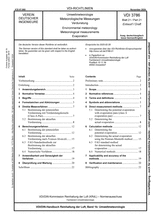Standards Worldwide
Standards Worldwide
Phone +49 30 58885700-07

Draft technical rule
VDI 3786 Blatt 21:2024-11 - Draft
Environmental meteorology - Meteorological measurements - Evaporation
- German title
- Umweltmeteorologie - Meteorologische Messungen - Verdunstung
- Publication date
- 2024-11
- Original language
- German, English
- Pages
- 23
- Publication date
- 2024-11
- Original language
- German, English
- Pages
- 23
Product information on this site:
Quick delivery via download or delivery service
Buy securely with a credit card or pay upon receipt of invoice
All transactions are encrypted
Short description
Evaporation describes the process of the transport of water vapour from surfaces, plants, and free water surfaces into the atmosphere. Together with precipitation and runoff, it is one of the hydrometeorological variables that connect meteorology and hydrology. Since the evaporation process requires energy, water vapour induces a latent energy transport (latent heat), whereby the release of energy occurs only during condensation. The stratification of the atmosphere, which is important for dispersal of air pollutants, is not only temperature- but also humidity-dependent (moist convection). Furthermore, the water vapour is essentially responsible for aerosol formation and is the most important greenhouse gas. Thus, evaporation has significant effects on all processes in the atmosphere, including the hydrological cycle, the climate, and weather events, therefore also the disperal and deposition air pollutants. Investigations concerning air quality monitoring that involve short-term phenomena and processes, require the actual evaporation, or else methods that provide evaporation data to derive mean values for time scales between 10 min and 60 min. Means derived for longer time scales are more suitable for climatological investigations. Since the methods are built on each other, it is the intention to provide an overview that is as complete as possible, and to highlighted potential limitations. This standard addresses municipalities, state offices (air, water, waste, ecology), environmental protection officers, labor inspectorates, state environmental offices, city and landscape planners and designers, airport companies, weather services, meteorological university institutes and consultants.
Content
ICS
07.060
Also available in
Loading recommended items...
Loading recommended items...
Loading recommended items...
Loading recommended items...
